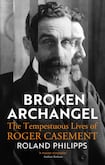
On August 3rd, 1916, Roger Casement was hanged in London’s Pentonville gaol, and buried in quicklime in the prison yard, three months after the execution of the leaders of the Easter Rising.
Several weeks previously, Casement had been baptised a Catholic by the Pentonville chaplain: the Catholic Archdiocese of Westminster, not quite willing to take possession of the soul of a now publicly notorious traitor and sexual deviant, had insisted that before Baptism could be countenanced, the prisoner must apologise for his crimes, “expressing sorrow for any scandal he might have caused by his acts, public or private”.
Casement declined to offer any such recantation — but he was baptised a Catholic anyway, the chaplain having the authority to offer comfort and salvation to a man facing death.
This was, by some accounts, Casement’s third experience of Baptism: while he had been received as an infant into the Anglican communion, it is claimed that he was baptised a Catholic at the age of four — and while scholars have debated as to whether this childhood Catholic Baptism ever took place, and where, and why, this layering of liturgical identities is of a piece with other facets of Roger Casement’s complex life.
The New Nuclear Age by Ankit Panda: Could ‘growing loose talk’ lead to the ultimate disaster?
Author Seán Farrell: ‘Dermot Bolger said there was a whiff of silage off my novel. I think that was a compliment’
Books in brief: The Princess of 72nd Street; The World Administered by Irishmen; The Lamb
The Boyhood of Cain by Michael Amherst: An interesting and unusual book told from a 12-year-old’s perspective
The Irish nationalist who had also served the Crown, the British diplomat who exposed the violent workings of colonial enterprises — and who was decorated for his actions before being executed by the British state for treachery; the homosexual whose private lives remained wholly unknown to those who imagined themselves close to him and the man whose affinity with the landscapes and seascapes of Ulster would lead for decades after his death to political tensions. All of these accretions, contradictions and more are explored in Roland Philipps’s vivid and compelling biography.
[ Book reviews: A swim around Ireland, GAA clubs and a history of the Soviet UnionOpens in new window ]
Broken Archangel — the title is taken from a histrionic description of Casement by his contemporary, TE Lawrence (of Arabia) — opens in late 1883 on the SS Bonny, as it sailed up the estuary of the Congo river to the port of Boma.
Casement was 19 years old and, as Philipps notes in a striking encapsulation of a personality unformed and still in reaction to a difficult upbringing, this young man “neither fully Irish nor fully English, neither Catholic nor Protestant, not at ease yet not a stranger in the British Isles, needed to escape the emotionally disjointed, peripatetic childhood that had ended with him a ward of Chancery under the care of a guardian in Ulster whom he barely knew”.
This, Casement’s first visit to the Belgian Congo, was the result of economic imperative: there was no family money, and two of his brothers had already been exported to the colonies. Now it was Casement’s turn to try his hand abroad — and the eventual result, in 1903, was a painstakingly accurate report delivered to the British foreign office detailing the sufferings of the people of this part of Africa at the hands of the Belgian regime.
Casement “could tell you things!” wrote Joseph Conrad, who encountered him in the Congo in 1890. “Things I have tried to forget, things I never did know.”
Philipps sets out skilfully the economic and political context that informed Casement’s work in central Africa, and later in South America, where similar levels of cruelty and depravity were in operation — and carefully examines the ambivalent reaction of his political masters to such reportage, complicated as it was by the demands of Realpolitik. But for Casement, this work was crucial to his growing understanding of how colonialism operated closer to home.
[ Lavery sketch of Irish patriot Roger Casement sells for 10 times guide priceOpens in new window ]
For students of Irish history, Casement’s courage and tragedy tend to be captured, unsurprisingly, in the image of a soaking man, 51 years old, staggering ashore at Banna on April 21st, 1916: the German arms ship he has organised scuttled, the Rising already doomed — and Casement himself rapidly arrested and transported to London for trial and death. Again, the context — and looming sense of doom — are evoked superbly: the visits to the United States and Norway, the long periods criss-crossing wartime Germany to raise awareness, funds and political support, and Casement’s isolation, loneliness and failing health.
As for Casement’s diaries detailing his homosexual encounters: Philipps is in no doubt of their authenticity, and he shows how rapidly Casement’s jottings were weaponised by a British state intent on weakening American support for the Rising and its surviving leader.
The tensions generated by the diaries as possible forgeries lingered: the 2023 State Papers show how Bertie Ahern wrote to Tony Blair in 1999, urging him to “throw some light” on the actions of the British intelligence services relating to the issue. But as WG Sebald observes: “It was precisely Casement’s homosexuality that sensitised him to the continuing oppression, exploitation, enslavement, and destruction, across the borders of social class and race, of those who were furthest from the centres of power.”













